Stone Restoration and Maintenance Corner – Diamond Abrasives
Bob Murrell
M3 Technologies
Photos by Bob Murrell
If you’re old enough, you may remember when commercial buildings in the 60s, 70s, and even 80s were constructed mostly of concrete, steel, and glass. This new look was trendy at the time, but nowhere near the timeless beauty of natural stone. Unfortunately, natural stone had become too costly to fabricate, especially with the existing tooling and methods of that time.
Folks, I’ve been in the business for well over 45 years now, off and on. I helped make silicon carbide bricks (Frankfurt and other style abrasives) for radial arm and automatic line machines when I was 12 years old (in 1970, for Greenstone Products). I used to hang out on Saturdays at Candoro Marble Company, here in Knoxville, because my Grandpa worked there. There were no industrial diamonds on the scene at that time, at least in general production, anyway. Even the gang saws (saws that cut blocks into slabs) were silicon carbide and or used sand as the cutting abrasive.
I then started working for my dad, Vic Green, at VicCo (later called Vic International) selling the Frankfurt bricks and other fabrication tools and equipment. I remember the first industrial diamond tools to hit the market, like core bits, blades, and such. Later, there were Frankfurt style diamonds. All of these diamonds were metal-bond (sintered) segment types. Soon, there were electroplated metal diamonds available and ultimately the resin-bond diamonds made their appearance.
Why use diamond abrasives? To start with, diamond is the hardest material you can use to polish, grind, or cut stone, being a 10 on the Mohs Hardness scale. Diamonds cut much faster than silicon carbide or other abrasive materials. They also hold their shape and sharpness much longer than softer materials. Because of these features, there is less abrasive material in the cutting wastewater (slurry). This is not as much of a problem in the fabrication and production facilities where they have plenty of water and are able to recycle (filter) the wastewater.
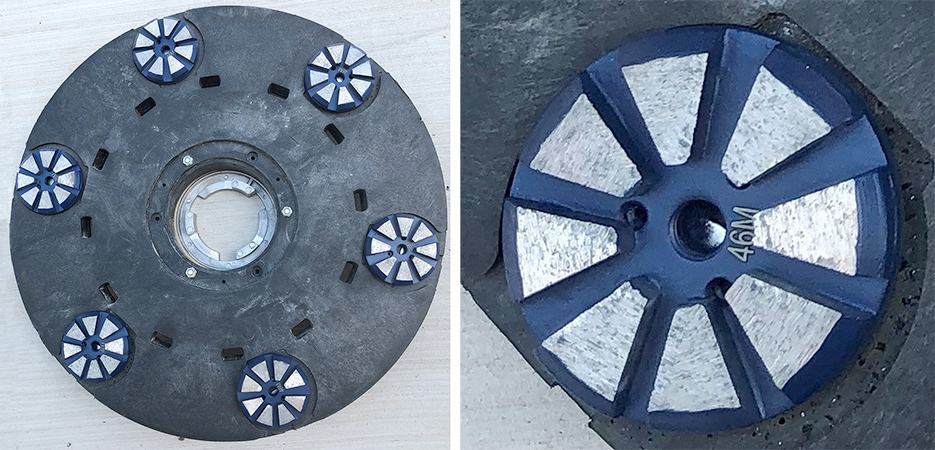 |
|
Segmented metal bond MAGNUM MAG3- 0400 grit mounted on a GRIP magnetic plate, closeup, at right. |
As restoration contractors, however, water usage must be managed to a much finer detail. Our operations are in commercial and residential structures, not in a plant with water recycling. We need the cutting speed and the longevity of diamond abrasives, and don’t need the massive amounts of water needed to run silicon carbide abrasives. So, diamond abrasives are the best tool for most stone, terrazzo, and concrete grinding, honing, and polishing operations.
Let’s discuss some of the most popular diamond abrasives for stone, terrazzo, and concrete restoration industries. Remember, our cutting operations are usually done wet, except for certain concrete applications. We do heavy grinding operations, like lippage removal, as an example. Standard honing operations, say for countertops and floor traffic wear lanes, are typically started with a 220 grit followed by a 400 grit and in some situations an 800 grit, prior to polishing with a 5X Gold or similar polishing abrasive.
Typically, coarse grinding operations are completed using a metal-bond diamond of some type, as these are the most aggressive. Honing operations are usually completed using resin-bond diamonds of some type, as these will provide a smoother finish. Epoxy resin diamonds tend to give a higher finish per grit level than do the phenolic resins, but the phenolics cut faster. I like the epoxy resins for most marble and similar stone countertop operations.
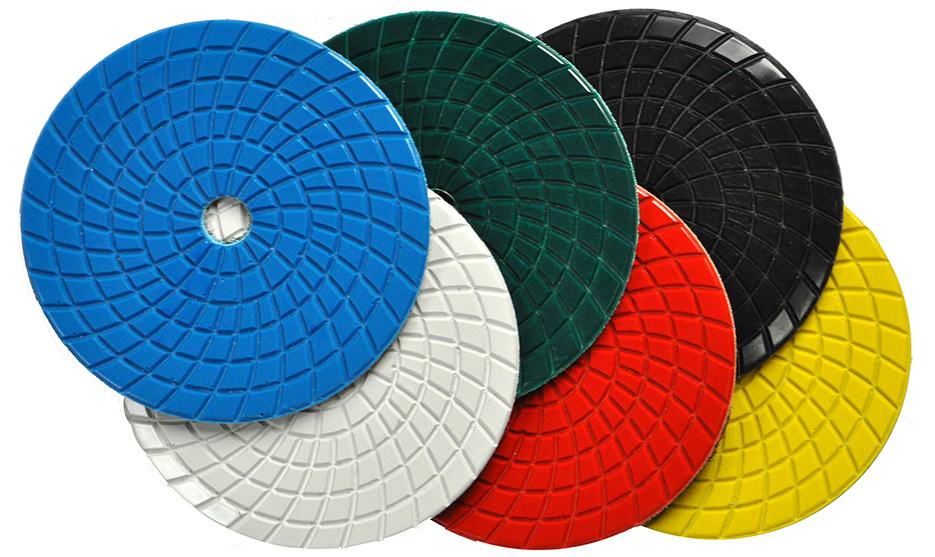 |
|
Above: AA Turbo Polishing PADS, epoxy resin discs
Below: Rosette epoxy resin discs |
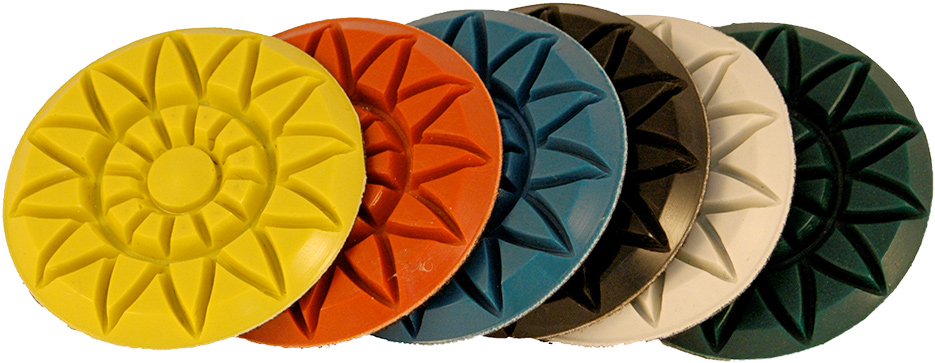 |
At M3 Technologies Inc. we have many diamond abrasives to choose from, based on the application. Our most popular epoxy resin-based diamonds are the Triple Thick TX 3-inch series for floors and the AA Turbo 5-inch for hand tool work. The AA Turbos come in several sizes, up to 7 inch. Made in Bulgaria, the TX resins are the standard in the industry for floor work. Both the TX and AA series cut fast and leave an excellent finish after each grit level. The TXs are somewhat flexible, which can help accommodate mild lippage on floors.
M3 Technologies also offers the TYP Typhoon resin discs and the Rosette resins, both of which are epoxy resin discs. Their performance is like that of the TXs. The differences are that the TYP are the thickest (this means less flexible than the TXs) epoxy resins M3 offers, and the Rosettes have a different water channel design. It is strictly a personal preference, based on the specific application. M3 Technologies’ Technical assistance can help with the correct choice.
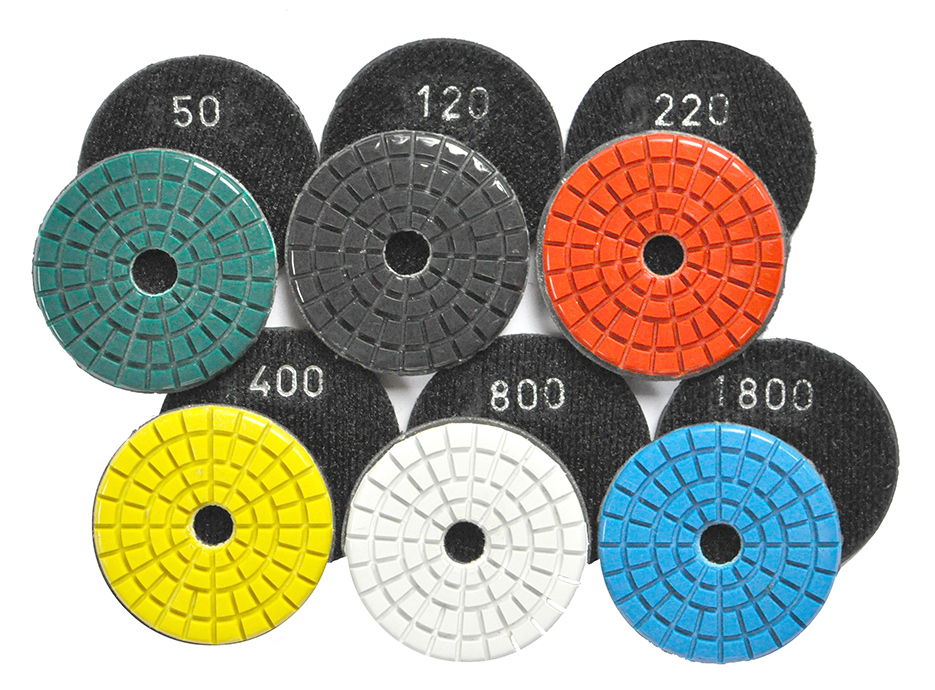 |
|
Above: TX Triple Thick epoxy resin diamond discs Below: DICP Ceramic Polishing discs are phenolic and ceramic resin discs. |
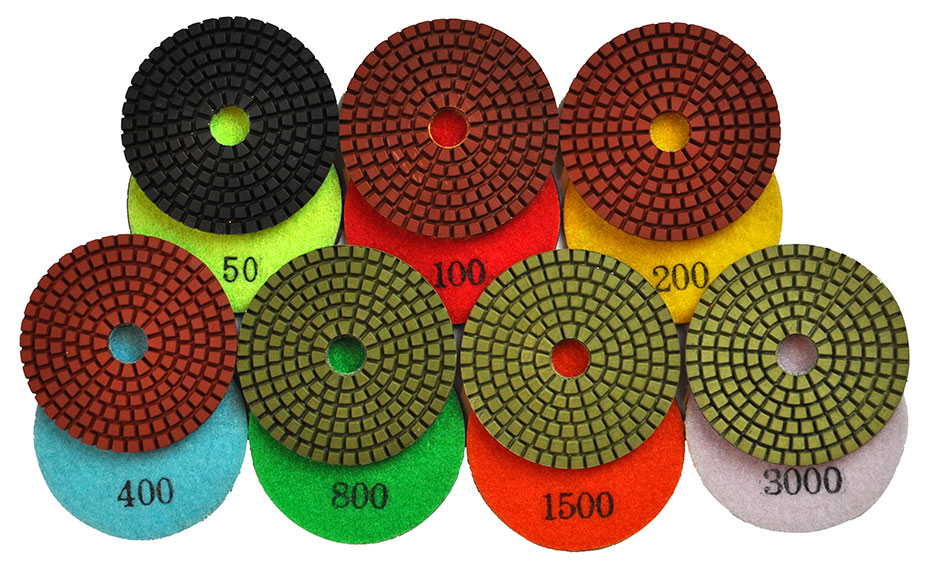 |
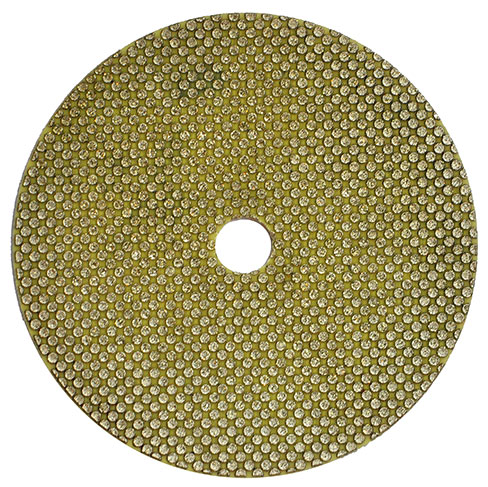 |
|
ELF series electroplated flexible diamond discs are recommended for heavy scratch repair. |
The Premium Flexible DICP series resin-bond diamonds are a great all-around diamond abrasive which works well on most any hard surface like marble, terrazzo, granite, some engineered stones, and concrete. They are phenolic resin with ceramic and will tend to cut faster than epoxies, but will not give the same shine level after each grit that the epoxies do. They are a great general-purpose diamond that I use for doing borders (edges on floors). I usually prefer the AA Turbos for marble countertops but the DICP5s will work, you will just need to take them up higher in the grit series to get the same look.
The Superior Hard Concrete HC3 resins are also phenolic and are designed specifically for concrete honing and polishing. They work very well under planetary machines as well as single disc machines, for both wet and dry operations. They will cut faster wet and last longer when used dry.
For heavier grinding operations like lippage removal, using one of the metal-bond diamond series is suggested. They will typically cut much faster and last longer than resins. There are basically 3 types of metal-bond diamonds: sintered (segmented), electroplated (rigid), and electroplated (flexible). Choosing the appropriate type for a particular project is best discussed with your supplier. For mild lippage and heavy scratch repair, I do like the flexible metal-bond ELF series. For heavy lippage and or heavy stock removal (like concrete grinding or surface prep), I would probably recommend either the segmented type, like The Magnum MAG3 series or the rigid electroplated type, like the Marble Lippage Removal LT series.
There are other diamond abrasive products like the PLP series diamond impregnated pads. These come in 100g through 12,000 grit and have many uses. They are available in sizes from 7 inch to 20 inch and larger.
I always recommend doing a test area on any project to confirm both the results and procedure. Also, the best way to help ensure success is by partnering with a good distributor, like BB Industries, that knows the business. They can help with technical support, product purchase decisions, logistics, and other pertinent project information.
Bob Murrell has worked in the natural stone industry for over 40 years and is well known for his expertise in natural stone, tile, and decorative concrete restoration and maintenance. He helped develop some of the main products and processes which revolutionized the industry, and is currently the Director of Operations for M3 Technologies. Send your comments and questions to Bob at attn:
publisher@slipperyrockgazette.net .